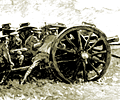














|
LESSON 10
The Homefront:
Factories, Women at Work, War Brides
Grade: 10
Time: one period (40 minutes)
Expectations:
Students will:
- demonstrate an understanding of how diverse groups and individuals
have contributed to the historical, cultural, and economic development
of Canada.
- identify and describe the achievements of Canadians who have contributed
significantly to the development of Canada and the world.
- demonstrate an understanding of the impact of World War I on the
veterans, their families, Canada as a whole and specific groups within
the country.
- use appropriate vocabulary to describe their inquiries and observations.
Preparation:
- Prepare notes for lecture and discussion on:
- what was happening in Canada during WW I
- financial situations of Canadians at home during WW I
- women's contiributions to WW I
- Copies of Personal Accounts from the Pier
21
Lesson Plan:
- Begin discussion and lecture based upon the notes researched by
the teacher on:
- What was happening at home?
- How did people feel?
- What about money?
- What could Women do?
- Discuss the increased need for production workers - who
would fill the gap?
- How did the government convince women to work in the factories?
Posters, National Pride, supporting the war effort.
- How did this change the lives of many women?
- Explain how a debate is held; the research done, the points to be
made, and the justifying of one's position. Discuss rules and expectations
prior to the debate.
- Debate - select team from hat Have students research one of
the following debating resolutions: Be it resolved that working changed
women's lives for the better. -OR- Be it resolved that working made women's
lives much more complicated in a time of war. Students must support all
points with evidence taken from the textbook, research, or the lecture
and discussion.
- After the debate, have sides summarize their points on chart paper
to be displayed in the class. Ideas to circulate include: Poor Wages, but
extra income, childcare dilemmas, societal expectations of women, lost
jobs when soldiers returned home, new found independence, and skills, etc...
Evaluation Opportunities:
- Observe and assess the type and extent of student participation in
whole class and small group discussion. Did they make a contribution
towards clarifying the issues and concepts under discussion. Did
they make observations and link ideas and facts? Were the points
valid towards supporting their debate topics?
- use rubric for evaluation
|




























